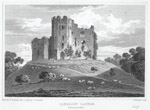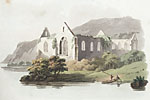
En poursuivant votre navigation sur ce site, vous acceptez l'utilisation de cookies. Ces derniers assurent le bon fonctionnement de nos services. En savoir plus.

You are here: About Cadw › News ›
Tuesday 05 January 2016

The encouraging end of year stats show growth on the 2014/15 figures, which were celebrated as being the best since the Great Britain Tourism Survey was set up in its present form in 2006.
From January to mid December 2015, more than 1.2 million people have explored the Cadw sites across Wales – an increase of 5.1 per cent.
The National Library of Wales has welcomed more than 40,700 visitors to its gallery in 2015 – an increase of 30 per cent compared to the previous year.
National Museum Cardiff was Amgueddfa Cymru – National Museum Wales’ biggest success in 2015, welcoming 6.5% more visitors from January to November 2015 compared with the previous year.
The latest results from the Great Britain Tourism Survey for January through to August show that the number of nights spent by GB visitors to Wales was up four per cent, while spend was up nine per cent.
Overseas visitor figures for the first quarter of 2015 show that Wales welcomed 137,000 overseas visitors – 5.4 per cent up on the first quarter of 2014.
One of Amgueddfa Cymru – National Museum Wales’ achievements in 2015 was the increase in overseas visitors. National Museum Cardiff was the biggest attraction for international tourists, with one in four (25%) of its visitors coming from overseas.
Cadw’s overseas visitors also increased by 3% over July and August 2015 compared to the same period in 2013. 19% of total visitors to Cadw sites were from overseas destinations, with the highest proportions coming from the USA (4%), Germany (3%), Australia (2%), France (2%) and the Netherlands (2%).
The figures have been welcomed by Ken Skates, Deputy Minister for Culture, Sport and Tourism, with the figures showing that visitors are choosing to explore Welsh culture and heritage sites throughout the year.
“Wales’s culture and heritage sites have enjoyed a bumper year of visits as people from within Wales, the wider UK and from overseas look to explore our rich heritage,” he said.
“A 5.1% uplift in visitors to Cadw sites is a testament to the both quality of the visitor experience and the work being done to promote historic sites to the public.
The increases in visitor numbers to the National Library and National Museum Wales are also encouraging, and it is pleasing to see more and more people are interested and are engaging with Welsh heritage by visiting cultural venues and historic attractions across the country.
I hope these iconic sites can continue to inspire the people of Wales and tourists alike to discover Welsh culture and heritage in 2016.”
Cadw’s multi award winning Lego themed ‘Pack your Imagination’ campaign helped boost figures over the peak summer, attracting more than 100,000 children over July and August.
The campaign was launched with a time-lapse video showing Rhuddlan castle being created from 50,000 pieces of Lego. Since the video was released the real castle has welcomed 25,896 visitors – a 24 per cent increase on 2014.
More than 193,000 people have enjoyed the improved visitor experience at Caernarfon Castle, and award winning interpretation at Blaenavon Ironworks has resulted in a 30 per cent increase in visitors to the site.
Harlech Castle has welcomed 87,826 visitors through its doors since January, with more than 23,000 people walking across the newly installed ‘floating bridge’ since its opening at the end of August. A 78% increase in visitor numbers has been reported at Harlech from September to mid December, following the opening of the new visitor centre.
Other contributing factors to the positive visitor figures include the hugely popular Wales-wide Open Doors celebration in September, pop-up cinema shows and the launch of the London tube-style Wales History Map.
The visitor figures have also had a positive impact on Cadw membership, which is at an all-time high. Cadw now has more than 25,500 members – an increase of 13 per cent on 2014/15.
The National Library of Wales’s key highlights included the main exhibition for Summer 2015, ‘Philip Jones Griffiths: A Welsh Focus on War and Peace’.
*Cadw is the Welsh Government's historic environment service, working for an accessible and well-protected historic environment for Wales

Cathédrale Saint-David
Du 21 au 28 juin 2016, aura lieu un pèlerinage au Pays de Galles , organisé par le diocèse de Saint-Brieuc.
Les pèlerins seront accompagnés du P. Maurice Roger pour une découverte du christianisme celtique fondé par Saint Illtud (seconde moitié du 5ème siècle), notamment dans le sud-est du Pays de Galles, à Dolgellau (jumelé avec Gwenrann/Guérande). Il fonda une école à Llanilltud Fawr et instruisit nombre de saints venus par la suite en Bretagne.
Durant ce voyage, vous passerez par Cardiff/Caerdydd, Cardigan, Swansea, Holywell, l'île de Caldey avec son monastère bénédictin érigé au XIIème siècle, la cathédrale anglicane de Saint-David (patron du Pays de Galles)...
Pour tous renseignements, conseils et inscriptions:
Direction diocésaine des Pèlerinages
Evèché
14 rue de l'évêché CS 82003 56001 VANNES/ GWENED cedex
Mail: pelerinages@diocese-vannes.fr
Tél.:0297683050 , du lundi au vendredi de 14hà 17h30

Pour les personnes intéressées, je vous donne ci-dessous un lien où vous trouverez une large bibliographie concernant la mythologie celtique : une mine d'or sur le sujet !
http://sejh.pagesperso-orange.fr/celtlink.html
une remarque: pourquoi n'avoir pas mis dans la rubrique BRETAGNE le texte original en breton du Barzaz Breiz ? Il faudrait corriger, mar plij !
• Llywodraeth Cymru : gouvernement du Pays de Galles
• office du tourisme du Pays de Galles
• noms de lieux anglais-gallois (avec le son)
• Principauté de Galles par Nicolas Sanson (1658)
• Wallia principatus vulgo Wales, par Joan Blaeu (1673)
• Map of Wales with remarks on teaching map geography, par William & Alexander Keith Johnston (XIXe)
• Llyfrgell Genedlaethol Cymru, Bibliothèque nationale du Pays de Galles
• the Principality of Wales par Thomas Taylor (1670-1730)
• Sea charts : cartes maritimes de Lewis Morris & William Morris
• Atlas of the Counties of Wales par George Philip (1895)
• cartes nautiques (XVIIIe) par Lewis & William Morris
• David Rumsey : cartes historiques & atlas anciens
• drapeau gallois (BBC)

En anglais, le Pays de Galles porte le nom de Wales, et gallois se dit Welsh. Pour les latins, les allemands ou les anglo-saxons, ce terme désigne les étrangers. Le W germanique correspond au G latin : Galles est donc l'équivalent français de l'anglais Wales (cf. Guillaume et William).
Le nom latin est Cumbria (en français : la Cambrie). Il a donné son nom à un comté anglais (mais non gallois !) : Cambria. Il sert aussi à désigner une ère préhistorique : le cambrien (et surtout le précambrien). Ces noms possèdent la même origine le nom gallois du pays : Cymru
La capitale du pays de Galles est Caerdydd (Cardiff, en anglais)
• BBC : histoire du pays de Galles & sites archéologiqes, historiques
• Dictionary of Welsh biographies : dictionnaire biographique 
• Topographical Dictionary of Wales de Samuel Lewis (1849)
 |
 |
• Multiculturalisme et régionalisme, les apories d'une identité britannique au pays de Galles, par Olivette Otele, in Observatoire de la société britannique (2008) 
• L'assemblée galloise et la question de l'environnement, de l'identité nationale à la construction politique, par Stéphanie Bory (2008) 
• Les étudiants gallois à l'université d'Oxford, 1282-1485, par Alexandre Delin (2013) 
• The Kymry : origine, histoire des Gallois, par Robert Owen (1891)
• Beautiful Wales par Edward Thomas (1905) avec gravures anciennes 
• Wild Wales, its people, language and scenery, par George Henry Borrow (1900)
• Bibliothèque nationale du Pays de Galles : cartes, manuscrits, gravures, photographies anciennes...
• livres en ligne sur le pays de Galles : Gallica | Persée | Revue.org | Google livres | Internet archive
• dessins, gravures anciennes (nypl)
• Yny lhyvyr hwnn : le premier livre imprimé en gallois (1546)
• la Bible (y Beibl) la traduction en gallois de William Morgan (1588)
-> cartes, atlas & cartes anciennes : collections de cartes de tous les pays
-> langues celtiques : présentation, carte, culture et civilisation
-> pratique > index